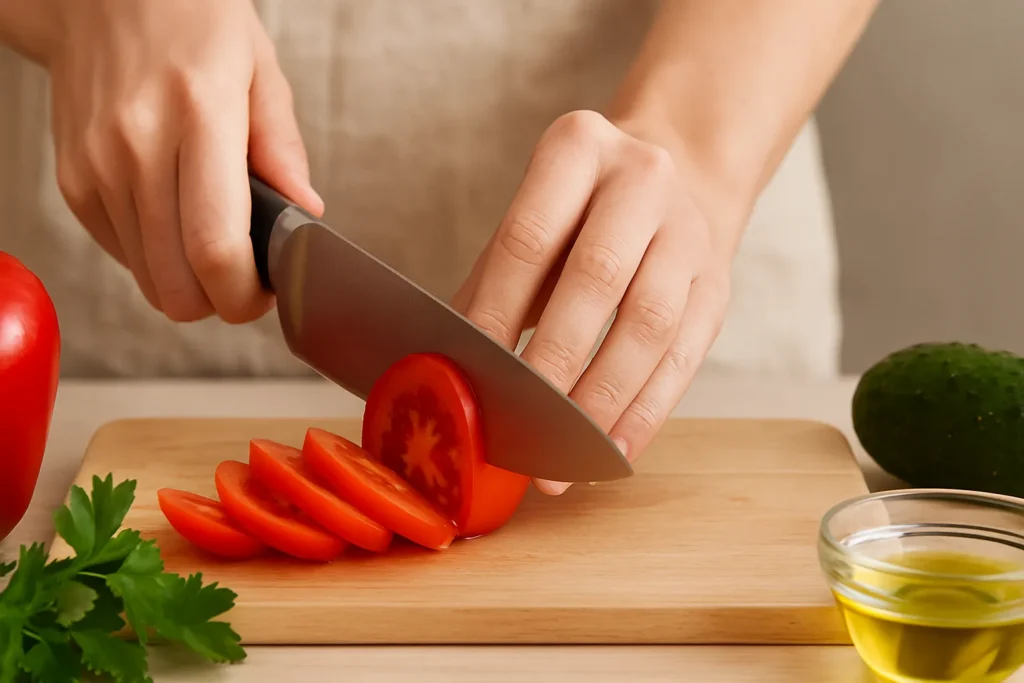
Ever watched a chef slice through vegetables like they’re butter and thought, “How do they do that?” Well, it’s not magic — it’s all about mastering knife skills! Whether you’re preparing a quick salad or getting ready for a multi-course meal, the way you handle your knife can elevate your cooking game from “meh” to “wow!” With the right techniques and a bit of practice, you’ll be chopping, slicing, and dicing like a seasoned professional in no time. Ready to take your kitchen skills to the next level? Let’s dive in!
1. The Right Knife for the Job
First things first: you can’t perform surgery with a butter knife, and you can’t cook like a pro with a dull, cheap blade. Invest in a good chef’s knife — about 8 inches is perfect for most tasks. A sharp knife is safer than a dull one (yes, really!), and it makes the job easier. When it comes to your knives, think of them like your trusty sidekick — the better your tool, the smoother your moves.
A quick tip: always use a cutting board (no, the counter isn’t a cutting board) and never cut towards your hand. We’re not making a horror movie here!
2. Basic Knife Techniques: Chop, Dice, and Slice
Now that you’ve got the right knife, let’s talk technique. While you might not need to channel your inner Gordon Ramsay just yet, learning the basics will make a world of difference.
- Chopping: This is the all-around move for cutting up larger ingredients like onions or carrots. Place your fingers like a claw and use the knife to cut straight down. Keep your knuckles in check — the knife should never touch your fingers.
- Dicing: Need uniform cubes? Dicing is the way to go. Start by cutting your vegetable into strips, then rotate and slice those strips into cubes. This is your go-to for everything from tomatoes to bell peppers.
- Slicing: For softer ingredients (like tomatoes or avocados), you’ll want a gentle rocking motion with the knife. Let the blade do the work. No pressing down or smashing — your goal is a clean, even slice.
3. The Rocking Motion: A Chef’s Secret
One of the most satisfying things to watch in the kitchen is a chef using that smooth rocking motion with their knife. Here’s how you can do it, too:
- Place the tip of your knife on the cutting board and gently rock it back and forth, using the weight of the knife to guide it through the ingredient. This motion is great for chopping herbs, garlic, and even tough things like butternut squash.
- The key to mastering the rocking motion is the wrist, not the whole arm. Think of it like playing the violin: it’s all in the subtle flicks. With practice, you’ll be able to chop through veggies like a pro without a single finger injury. (Well, hopefully!)
4. Knife Safety: No Drama, Just Technique
You might have watched one too many cooking shows where someone almost cuts off their finger, but with a little bit of focus, accidents are totally avoidable. Here are some simple tips:
- The Claw: Always use your fingers like a claw when holding ingredients. This will protect them from the blade and keep you from slicing into your hand (ouch!).
- The Pinch Grip: Hold the knife with your thumb and index finger gripping the blade (not the handle) for better control. This allows for more precise cuts and less chance of slipping.
- Stay Present: It’s easy to zone out when you’re chopping away, but focusing on what you’re doing (and keeping your knife sharp) is the best way to avoid accidents.
5. Knife Care: Treat Your Blade Right
Just like a relationship, your knife needs a little TLC. After every use, give it a quick wash (by hand, not in the dishwasher), and dry it thoroughly to prevent rusting. Store your knives in a block or on a magnetic strip to keep the blades safe.
Pro tip: every once in a while, hone your knife with a sharpening steel. This won’t sharpen it, but it’ll help realign the blade, keeping it sharp for longer.
6. Advanced Knife Skills: The Art of Julienne and Brunoise
Once you’ve mastered the basics, you can move on to more advanced techniques that will make you look like a true kitchen wizard.
- Julienne: This technique creates thin matchstick-like strips, perfect for veggies like carrots or zucchini. To julienne, cut the ingredient into slabs, stack them up, and slice them into thin strips. It’s like cutting a vegetable into the smallest, most elegant fries.
- Brunoise: If you’re feeling fancy, brunoise is the art of cutting ingredients into perfect tiny cubes. It’s often used for garnishes, but once you’ve mastered the technique, you can add these tiny cubes of perfection to your salads or sauces.
7. Speed and Precision: Cutting Without the Rush
At first, you’ll probably feel like a sloth with a knife. That’s totally normal! Knife skills take time to develop, but don’t rush it. Focus on precision, not speed. The more you practice, the quicker you’ll get. Eventually, chopping vegetables will feel like second nature, and you’ll impress yourself (and anyone watching). So, take a deep breath, steady your hand, and start slicing!
